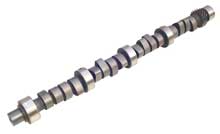Special Profile Camshaft
NEW lobe profiles and valve timing applied to conventional camshaft
Negative Pressure Supercharging camshaft uses...

|
1)
|
High lift intake profiles to increase air flow into the engine from idle to peak rpm
|
|
2)
|
Low lift exhaust profiles to, A) produce a high gas velocity in order to create the lower pressure (higher vacuum) needed to pull a larger volume of air into the engine and B) prevent the Negative Supercharging header from pulling the intake charge into the exhaust system during the overlap period
|
|
3)
|
Synchronised valve timing to produce, control and enhance the Negative Pressure Supercharging process. For more details see Negative Supercharging Valve Timing
|
Negative Pressure Supercharging produces more torque and horsepower FROM idle to peak rpm the HIGHER the intake lift and the LARGER the intake port
The high gas velocity produced by the low exhaust lift of the Negative Supercharging camshaft and small primary pipe of the Negative Supercharging header, produces a much greater pressure differential between atmospheric pressure and cylinder pressure during the intake stroke. This pulls a larger volume of air into the cylinder at a higher velocity. As a result it allows high intake lift and large intake ports to produce a lot more torque and horsepower from idle to peak rpm than intakes with low lift and small ports.
Negative Pressure Supercharging camshaft works in only one optimum installed position and can NOT be advanced or retarded to move the power band like conventional cams
Also, Negative Pressure Supercharging produces such a huge increase in torque and horsepower over a wider rpm range and faster acceleration from idle to peak rpm, there is no need to advance or retard the camshaft in order to improve low end or top end power.
For example,
If the Negative Pressure Supercharging camshaft is...
|
•
|
Advanced or retarded by more than 2° and no more than 6° from the optimum installed position the engine will REDUCE power the more the cam is advanced or retarded
|
|
•
|
Advanced by more than 6° from the optimum installed position the engine will further REDUCE power
|
|
•
|
Retarded by more than 6° from the optimum installed position the engine will LOSE all power
|
Therefore,
The Negative Pressure Supercharging camshaft MUST be dialed-in (degreed-in) to the optimum installed position
If the Negative Supercharging camshaft is installed in the engine by only aligning the dots on the crank and cam sprockets the valve timing may not be in the optimum position. For example, if the installed position of the camshaft is more than 2-6° from optimum the engine will produce poor performance or lose all power. For more details see above. Therefore, the camshaft MUST be dialed-in (degreed-in) to the optimum installed position specified in the Negative Supercharging technical manual.
Also, the Negative Supercharging camshaft is installed 2° advanced in order to keep the camshaft in the optimum position as the timing chain stretches over many thousands of miles and retards the valve timing. This allows the engine to run reliably with Negative Pressure Supercharging for over 100,000 miles (160,000 km) before the timing chain needs to be replaced.
| Impulse Engine Technology
P/L |
PO Box 986 Randwick NSW 2031 Australia
Ph: (02) 9398 5544
Fax: (02) 9398 5644
International: Ph: +(612) 9398 5544
Fax: +(612) 9398 5644
Email Us
Inventor of Negative Pressure Supercharging
|
|


